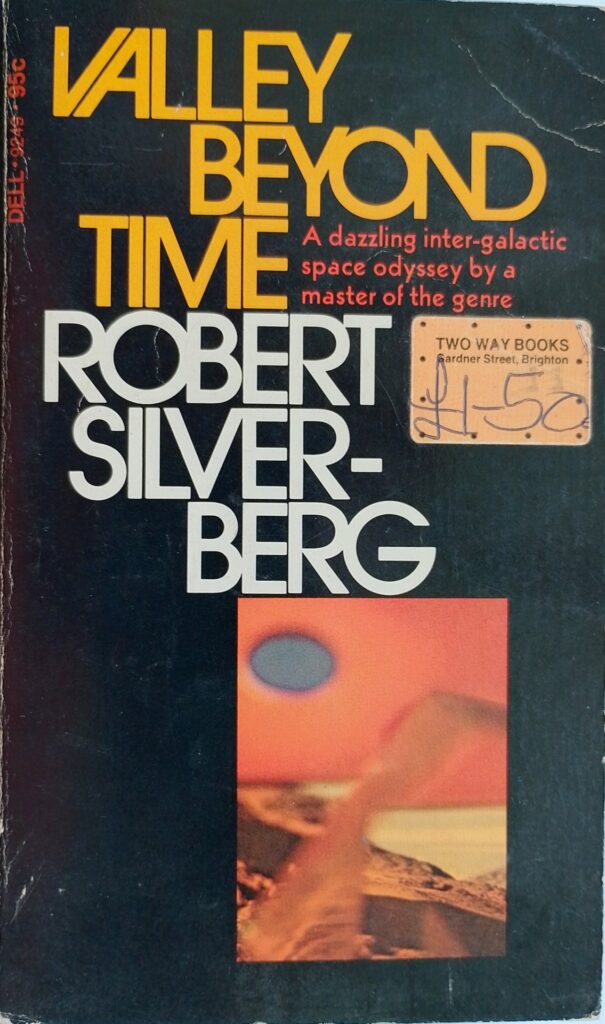First published 1957-8. Dell paperback, 1973, pp 223, c.55,000 words.
This is a collection of four quite long short stories that were put together as a book some twelve years after being first published elsewhere. Silverberg provides an introduction to the compilation, which is interesting in itself. In it he explains that these stories were written when he was in his early twenties, and are action oriented. The stories have a consistency of prose style that allow them to be satisfactorily placed together.
The first story gives its name to the collection. Sam Thornhill is admiring his home valley when he sees a man and a woman approach. He wonders what they want. They enlighten him that he hasn’t always lived here but, like them, has suddenly awoken to find them selves mysteriously transported to this idyllic place, broad and lush, but surrounded by massive mountains. Is this purgatory, and all these people, and there is a small group of them, some human, some alien, have died and woken here? They seem to be prevented from leaving, although food rains down regularly. The creepy atmosphere is well drawn as this disparate group explore the limits of the valley and their own desires and fears. There is clearly a vivid imagination at work here in this intriguing tale.
The Flame and the Hammer concerns a galaxy where a powerful emperor has held control for many decades through ruthlessness and cunning. Worlds far from the galactic centre resent their subservience and one maintains legends of a mysterious device which will allow them to liberate themselves, yet no one knows what or where the device is. Imperial forces try to find the secret which furthers resentment and leads to rebellion. This is in some ways a straightforward tale of repression and rebellion, but it is lifted from the banal by the psychological power of legend.
The Wages of Death is another tale of the rebellion of the fringe against the centre. In this case the founding story of the United States is even more clearly present. This one is made distinct by being told primarily from a loyalist’s point of view. The loyalist recognising that those seeking freedom may be heading into greater repression. Perhaps the communist rebellions against repressive autocracies were in Silverberg’s mind.
The final story, Spacerogue, also dwells on the theme of rebellion against a repressive regime, only in this case it is an individual who seeks vergence by worming his way into the court of the autocrat. Again, it is powerfully imaginative.
Each of these stories sucks one into their individual worlds and can be enjoyed individually. Together they are a fine exploration of acts of rebellion against seemingly overwhelmingly powerful authority.
As always in SF, there are limits to the author’s ability to escape the present. Most jarringly this is revealed in the roles of men and women – it is nearly always the men giving the orders [e.g. p57, p181]. Sometimes it is just amusing that archaic technology is in use in the far future. Here a message is ‘inscribed on a coiled tape’ [p85], suggesting there is no digital coms. There are ‘music tapes’ [p86], and paper ID [p93] and buildings are still made of bricks [p97].
Silverberg has a very accessible writing style, that is a cut above the usual pot-boiler narratives of even some of the SF luminaries like Arthur C. Clark, Isacc Asimov and others. Once he uses the archaic word ‘limned’ [p212], but the meaning is clear enough from the context.
Overall this collection displays Silverberg’s imaginative power in a set of highly entertaining stories, cleverly exploring aspects of the theme of rebellion.
Wikipedia biography of Silverberg: https://en.wikipedia.org/wiki/Robert_Silverberg
Others’ reviews of the book: https://www.goodreads.com/book/show/41566116-valley-beyond-time?from_search=true&from_srp=true&qid=COzjI8JzSy&rank=2
© William John Graham, July 2023

